Lactarius piperatus (L.) Pers. - Peppery Milkcap
Phylum: Basidiomycota - Class: Agaricomycetes - Order: Russulales - Family: Russulaceae
Distribution - Taxonomic History - Etymology - Identification - Culinary Notes - Reference Sources
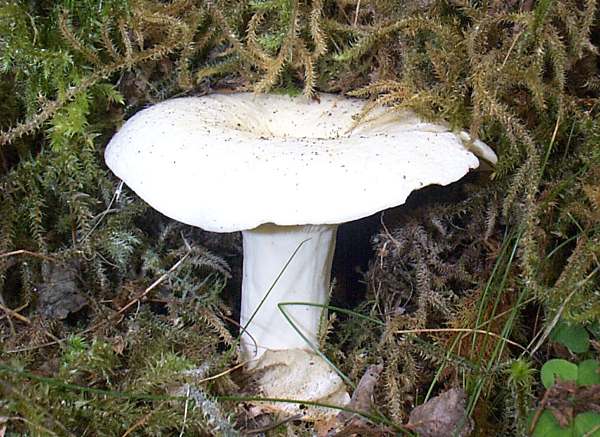
Surely only a mushroom would wear white and then choose to live in a mucky place where finery can never be shown off to its best! Like the Fleecy Milkcap Lactarius vellereus, which almost invariably has lumps of earth and leaf litter adorning its pallid cap, the Peppery Milkcap Lactarius piperatus rarely shows its true colours: by the time a fruitbody is fully developed, its funnel-shaped cap often contains a diverse ecosystem of dead (and sometimes living) plant and animal organisms.
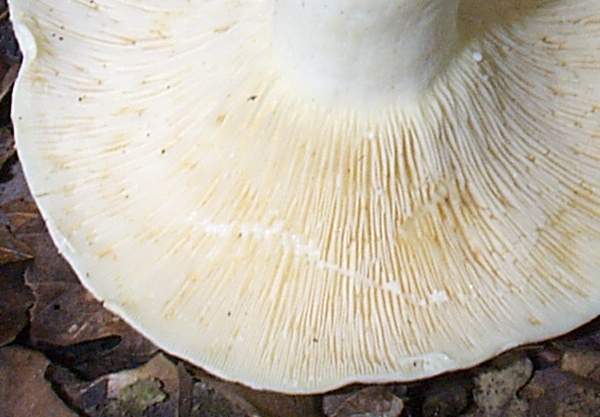
As illustrated above, this chunky woodland milkcap has very crowded gills, a feature that clearly distinguishes it from the Fleecy Milkcap Lactarius vellereus (pictured below) which has gills that are much more widely spaced.
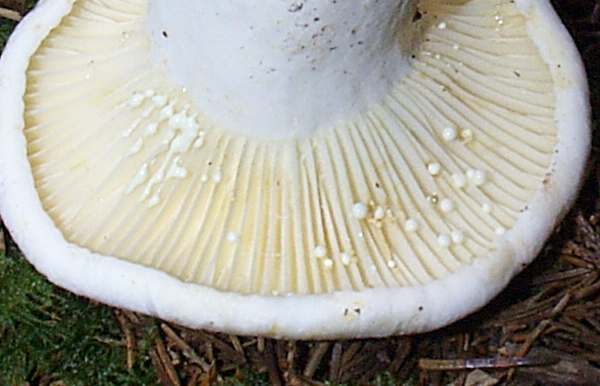
These occasional mushrooms of deciduous and mixed woodland sometimes grow in rings, but more often they occur as solitary specimens or in very small groups.
It is worth getting to recognise this milkcap from its crowded gills, long stem and scaleless cap: a taste test is a most unpleasant experience!
Distribution
Found only occasionally throughout most of Britain and Ireland, but in a few places locally common, the Peppery Milkcap occurs on mainland Europe and in parts on North America. In Australia this milkcap is an introduced species.
Taxonomic history
The Peppery Milkcap was described in 1773 by Carl Linnaeus, who established its basionym when he gave it the binomial scientific name Agaricus piperatus. It was Christiaan Hendrik Persoon who in 1797 transferred this species to the genus Lactarius, thus establishing its currently-accepted scientific name Lactarius piperatus.
Synonyms of Lactarius piperatus include Lactarius pergamenus, Agaricus piperatus L., and Agaricus lactifluus var. piperatus (L.) Pers.
Etymology
The generic name Lactarius means producing milk (lactating) - a reference to the milky latex that is exuded from the gills of milkcap fungi when they are cut or torn. The specific epithet piperatus is a Latin adjective meaning peppery.
While the British Mycological Society's list of English Names of Fungi lists Lactarius piperatus as the Peppery Milkcap, in the past it was known as the Peppery Milk-cap. In the USA its common name is Peppery Milk Cap.
Identification guide
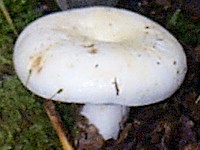 |
Cap10 to 16cm in diameter, convex with a tightly inrolled margin and later depressed or funnel-shaped, the creamy-white caps have a fine matt surface. Older specimens often develop reddish patches. Beneath the cap cuticle the white flesh is thick and brittle. |
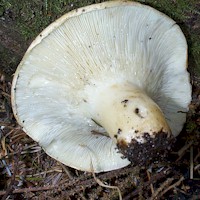 |
GillsThe very narrow, decurrent, crowded gills are a distinguishing feature of this milkcap mushroom; they are white at first, becoming brown with age. When damaged, the gills exude very hot and acrid white milk that turns pale green after an hour or two. Stem2 to 3cm in diameter and 4 to 8cm tall, the fairly smooth stems taper in slightly towards the base; they become hollow as the fruiting body ages. |
SporesEllipsoidal, 8-9 x 6-7µm; ornamented with a few small warts and narrow ridges to 0.5µm tall that have some cross connections forming a very incomplete network. Spore printWhite. |
|
Odour/taste |
No distinctive odour; a very hot and peppery taste. |
Habitat & Ecological role |
Broadleaf and mixed woodland; most commonly under Beech trees.. |
Season |
July to November in Britain and Ireland. |
Similar species |
Lactarius vellereus has a fleecy cap and its stem is relatively short. Lactarius pubescens has a pink tinge to the cap and gills; it has a woolly inrolled margin and a less strongly acrid taste. |
Culinary Notes
Much too hot and peppery for most western European palates, this mushroom is quite popular in India and in certain eastern European countries. If you are keen to try them but don't fancy destroying your taste buds, Peppery Milkcaps can be dried and used (judiciously, of course) as a substitute for pepper.
Reference Sources
Fascinated by Fungi, 2nd Edition, Pat O'Reilly 2016, reprinted by Coch-y-bonddu Books in 2022.
Funga Nordica, Henning Knudsen and Jan Vesterholt, 2008.
Fungi of Switzerland, volume 6: Russulaceae, Kränzlin, F.
BMS List of English Names for Fungi.
Dictionary of the Fungi; Paul M. Kirk, Paul F. Cannon, David W. Minter and J. A. Stalpers; CABI, 2008
Taxonomic history and synonym information on these pages is drawn from many sources but in particular from the British Mycological Society's GB Checklist of Fungi.
Fascinated by Fungi. Back by popular demand, Pat O'Reilly's best-selling 450-page hardback book is available now. The latest second edition was republished with a sparkling new cover design in September 2022 by Coch-y-Bonddu Books. Full details and copies are available from the publisher's online bookshop...

